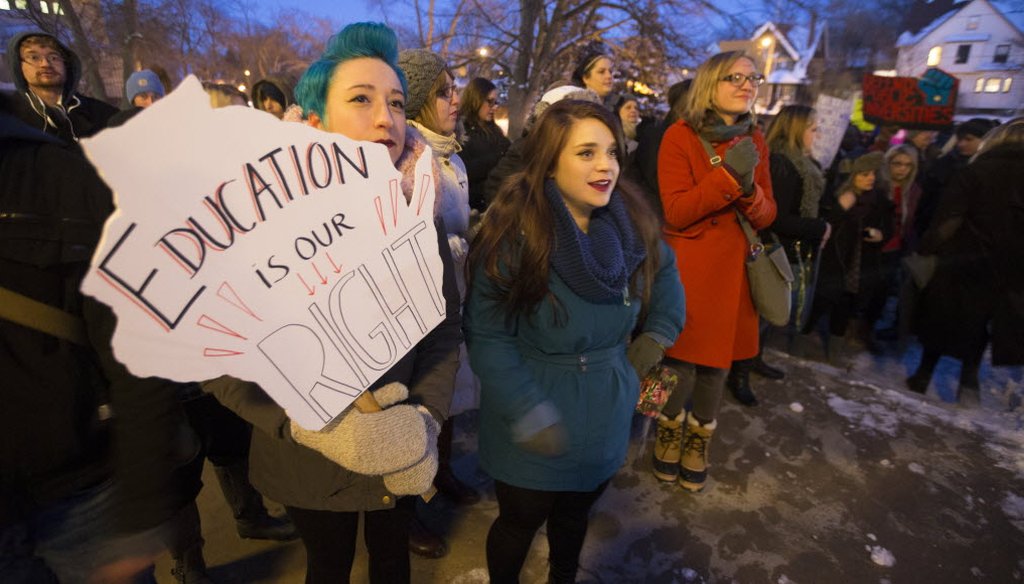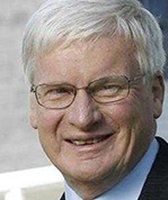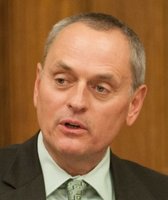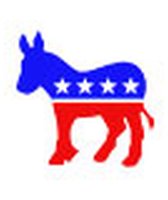Get PolitiFact in your inbox.

Students and faculty members of the University of Wisconsin-Milwaukee participated in a rally on Feb. 4, 2015 to protest a two-year, $300 million budget cut for the University of Wisconsin System that was proposed by Gov. Scott Walker.
Gov. Scott Walker took to social media to downplay the scope of his cuts in funding to the University of Wisconsin system in his 2015-’17 budget proposal.
"Our budget changes are only 2.5% of the total UW System operating budget," Walker posted Feb. 7, 2015 on Facebook.
Media outlets, meanwhile, headlined a 13 percent drop in state funding -- the figure that Walker’s own budget shop published.
And university officials Feb. 13, 2015 pegged it higher still, as a 16 percent reduction in state aid compared to the current budget.
So which is it?
The 13 percent figure draws general support from experts, but here is another credible answer: None of the above.
All of the numbers being used are real numbers, but all come from different comparisons that yield a rhetorical advantage for one side or the other in the contentious budget debate.
We found a middle-ground perspective that has barely surfaced so far in the debate: A 6 percent reduction.
Here’s the math to get there: Walker’s budget calls for a cut of $150 million in state funding for UW campuses for both 2015-’16 and 2016-’17.
And while the system’s total budget is $6.1 billion -- when you factor in state aid, tuition, federal grants and all sources of income -- only $2.4 billion of that can be shifted around to meet budget gaps.
Using that $2.4 billion as the benchmark, the $150 million cut would be 6.25 percent.
That comparison helps put Walker’s cut into perspective, according to the research director at the Wisconsin Council on Children & Families, Jon Peacock.
Of course, UW officials would not be able to boost tuition rates because Walker’s budget maintains a two-year freeze on tuition.
Todd Berry, president of the Wisconsin Taxpayers Alliance, thinks that freeze limits the usefulness of the 6 percent figure.
But others note that UW has the same ability to shift around tuition money as it does general state aid. Those two sources go into one big pot.
For his part, Walker says spinning off the UW system as an independent public authority, as he proposed, will help officials save money and actually help recruit top faculty and attract more research funding down the road.
UW-Madison Chancellor Rebecca Blank, meanwhile, says faculty recruiting has been hurt and that the cut will mean layoffs and harm to the school’s mission.
Walker’s number
The number that tells Wisconsinites the least about the impact of the cuts is Walker’s.
If you take the overall $6.1 billion system budget, the $150 million per year cut does represent 2.5 percent.
But Berry and Peacock, who closely watch the budget at their private research organizations, called that comparison misleading.
In reality, UW can’t tap into some $3.7 billion of that because the money is from federal research grants, gifts for specific purposes and fees that pay for athletics and other programs. Even federal student loan money that UW simply passes along to students gets counted in the overall budget.
If you drop by Memorial Union and hoist a cup of beer, that cash stays in a segregated fund and can’t be used to pay an English professor’s salary.
A research grant into cancer cures can’t be diverted to pay for lighting in the chancellor’s office in Madison.
And so on.
"These monies are not unrestricted," noted Berry. "They are often earmarked and cannot be used interchangeably with (general state aid)."
Walker spokeswoman Laurel Patrick said UW officials are trying to have it both ways in the numbers debate.
Last year, she noted, when lawmakers criticized UW for hoarding $600 million in surplus dollars, system officials compared the surplus -- they said it was $175 million -- to the overall $6 billion budget, an effort to attach the smallest possible percentage to the figure.
13 percent solution?
Berry and Peacock said they preferred describing Walker’s budget as a 13 percent cut. That is most instructive if stated correctly, they said.
After all, Walker’s cut came in a specific category -- state "general purpose" aid -- that will fall by 13 percent if the Legislature agrees. His own budget officials called it a 13 percent reduction.
"I’ve followed the budget process for more than 30 years, and the public discussion about the budget has always focused primarily on the state’s priorities in spending (and raising) state general purpose revenue," said Peacock.
UW officials argue the 13 percent increases to 16 percent if you exclude required debt payments -- related to UW construction projects -- from the state aid amount.
That point is a defensible one. It’s true UW can’t find savings in that budget line because it doesn’t control those payments. But the system does benefit from the buildings.
Our two experts offered some interesting footnotes to the debate over how to quantify Walker’s cuts.
Some have said increased private fundraising could help fill budget holes. But Berry said really only the Madison campus has extensive fundraising capacity, and it often comes with strings attached.
"Madison alumni give money to Madison for specific reasons, not to replace tax dollars or to be spent for unspecified reasons," Berry said.
Peacock said all the figures are somewhat inadequate, because they don’t factor in inflationary pressures.
"For all practical purposes, even if we simply froze spending, that would amount to a cut as inflation erodes the purchasing power of the revenue," he said. "It would be better to measure the proposed funding against a cost-to-continue baseline that factors in the cost drivers."
Finally, there’s the ongoing argument over whether UW could cover the cuts with funds it has squirreled away in reserves.
The UW System told the Milwaukee Journal Sentinel in February 2015 that it did have about $1.3 billion in cash balances as of Dec. 31, 2014.
But UW System President Ray Cross said it was misleading to suggest, as a Walker aide did, that reserves could cover the $300 million cut.
His reasoning, of course, is familiar: large portions of the reserves are legally restricted to particular accounts and cannot be moved.
Our Sources
Interview with Alexander Hummel, University of Wisconsin System spokesman, Feb. 13, 2015
Interview with Laurel Patrick, Walker spokeswoman, Feb. 13, 2015
Interview with Jon Peacock, research director, Wisconsin Council on Children & Families, Feb. 13, 2015
Interview with Todd Berry, president of Wisconsin Taxpayers Alliance, Feb. 16, 2015
Interview with Emily Pope, higher education analyst, Legislative Fiscal Bureau, Feb. 13, 2015
Legislative Fiscal Bureau, informational paper, University of Wisconsin System Overview, January 2015
Department of Administration budget documents for 2015-17













































